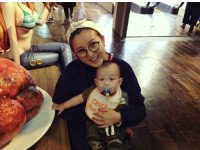listview滑动源码分析(二)
来源:互联网 发布:微云直链解析php源码 编辑:程序博客网 时间:2024/06/06 03:30
4, listview滑动刷新
刷新流程如下,
主要是trackMotionScroll方法, 当于手指只要在屏幕上稍微有一点点移动,这个方法就会被调用,而如果是正常在屏幕上滑动的话,那么这个方法就会被调用很多次。
boolean trackMotionScroll(int deltaY, int incrementalDeltaY) { final int childCount = getChildCount(); •••int start = 0; int count = 0; // item移动的数量if (down) { // 手指往上滑动 int top = -incrementalDeltaY; if ((mGroupFlags & CLIP_TO_PADDING_MASK) == CLIP_TO_PADDING_MASK) { top += listPadding.top; } for (int i = 0; i < childCount; i++) { final View child = getChildAt(i); if (child.getBottom() >= top) { break; } else { count++; int position = firstPosition + i; if (position >= headerViewsCount && position < footerViewsStart) { // The view will be rebound to new data, clear any // system-managed transient state. child.clearAccessibilityFocus(); mRecycler.addScrapView(child, position); } } } } else { //手指往下滑动 int bottom = getHeight() - incrementalDeltaY; if ((mGroupFlags & CLIP_TO_PADDING_MASK) == CLIP_TO_PADDING_MASK) { bottom -= listPadding.bottom; } for (int i = childCount - 1; i >= 0; i--) { final View child = getChildAt(i); if (child.getTop() <= bottom) { break; } else { start = i; count++; int position = firstPosition + i; if (position >= headerViewsCount && position < footerViewsStart) { // The view will be rebound to new data, clear any // system-managed transient state. child.clearAccessibilityFocus(); mRecycler.addScrapView(child, position); } } } }••••if (count > 0) { detachViewsFromParent(start, count); mRecycler.removeSkippedScrap(); }•••• offsetChildrenTopAndBottom(incrementalDeltaY); if (down) { mFirstPosition += count; } final int absIncrementalDeltaY = Math.abs(incrementalDeltaY); if (spaceAbove < absIncrementalDeltaY || spaceBelow < absIncrementalDeltaY) { fillGap(down); }•••}1,无论向上还是向下滑动,调用addScrapView方法缓存滑出的View
2,调用offsetChildrenTopAndBottom 方法,将ListView中所有的子View都按照传入的参数值进行相应的偏移,这样就实现了随着手指的拖动,ListView的内容也会随着滚动的效果。
3, 如果ListView中最后一个View的底部已经移入了屏幕,或者ListView中第一个View的顶部移入了屏幕,就会调用fillGap()方法,加载屏幕外数据。
Listview中的fillGap方法源码如下,
void fillGap(boolean down) { final int count = getChildCount(); if (down) { // 向上滑 int paddingTop = 0; if ((mGroupFlags & CLIP_TO_PADDING_MASK) == CLIP_TO_PADDING_MASK) { paddingTop = getListPaddingTop(); } final int startOffset = count > 0 ? getChildAt(count - 1).getBottom() + mDividerHeight : paddingTop; fillDown(mFirstPosition + count, startOffset); correctTooHigh(getChildCount()); } else { // 向下滑 int paddingBottom = 0; if ((mGroupFlags & CLIP_TO_PADDING_MASK) == CLIP_TO_PADDING_MASK) { paddingBottom = getListPaddingBottom(); } final int startOffset = count > 0 ? getChildAt(0).getTop() - mDividerHeight : getHeight() - paddingBottom; fillUp(mFirstPosition - 1, startOffset); correctTooLow(getChildCount()); } }fillDown和fillUp方法内部都是通过一个循环调用makeAndAddView方法对ListView进行填充。再次查看makeAndAddView方法,
private View makeAndAddView(int position, int y, boolean flow, int childrenLeft, boolean selected) { View child; if (!mDataChanged) { // Try to use an existing view for this position child = mRecycler.getActiveView(position); if (child != null) { // Found it -- we're using an existing child // This just needs to be positioned setupChild(child, position, y, flow, childrenLeft, selected, true); return child; } } // Make a new view for this position, or convert an unused view if possible child = obtainView(position, mIsScrap); // This needs to be positioned and measured setupChild(child, position, y, flow, childrenLeft, selected, mIsScrap[0]); return child; }首先仍然是会尝试调用RecycleBin的getActiveView()方法来获取子布局,只不过肯定是获取不到的了,因为在第二次Layout过程中我们已经从mActiveViews中获取过了数据,而根据RecycleBin的机制,mActiveViews是不能够重复利用的,因此这里返回的值肯定是null。所以会调用obtainView方法。
obtainView方法如下,
View obtainView(int position, boolean[] isScrap) { Trace.traceBegin(Trace.TRACE_TAG_VIEW, "obtainView"); isScrap[0] = false; // Check whether we have a transient state view. Attempt to re-bind the // data and discard the view if we fail. final View transientView = mRecycler.getTransientStateView(position); if (transientView != null) {// 短暂view的缓存,原理和一般缓存一样。 final LayoutParams params = (LayoutParams) transientView.getLayoutParams(); // If the view type hasn't changed, attempt to re-bind the data. if (params.viewType == mAdapter.getItemViewType(position)) { final View updatedView = mAdapter.getView(position, transientView, this); // If we failed to re-bind the data, scrap the obtained view. if (updatedView != transientView) { setItemViewLayoutParams(updatedView, position); mRecycler.addScrapView(updatedView, position); } } isScrap[0] = true; // Finish the temporary detach started in addScrapView(). transientView.dispatchFinishTemporaryDetach(); return transientView; } final View scrapView = mRecycler.getScrapView(position); final View child = mAdapter.getView(position, scrapView, this); if (scrapView != null) { if (child != scrapView) { // Failed to re-bind the data, return scrap to the heap. mRecycler.addScrapView(scrapView, position); } else { isScrap[0] = true; // Finish the temporary detach started in addScrapView(). child.dispatchFinishTemporaryDetach(); } } if (mCacheColorHint != 0) { child.setDrawingCacheBackgroundColor(mCacheColorHint); } if (child.getImportantForAccessibility() == IMPORTANT_FOR_ACCESSIBILITY_AUTO) { child.setImportantForAccessibility(IMPORTANT_FOR_ACCESSIBILITY_YES); } setItemViewLayoutParams(child, position); if (AccessibilityManager.getInstance(mContext).isEnabled()) { if (mAccessibilityDelegate == null) { mAccessibilityDelegate = new ListItemAccessibilityDelegate(); } if (child.getAccessibilityDelegate() == null) { child.setAccessibilityDelegate(mAccessibilityDelegate); } } Trace.traceEnd(Trace.TRACE_TAG_VIEW); return child; }1,首先判断是否存在短暂缓存,如果存在,从短暂缓存中获取view
2, 调用getScrapView()方法来尝试从废弃缓存中获取一个View. 在trackMotionScroll()方法中我们就已经看到了,一旦有任何子View被移出了屏幕,就会将它加入到废弃缓存中,而从obtainView()方法中的逻辑来看,一旦有新的数据需要显示到屏幕上,就会尝试从废弃缓存中获取View。所以它们之间就形成了一个生产者和消费者的模式,那么ListView神奇的地方也就在这里体现出来了,不管你有任意多条数据需要显示,ListView中的子View其实来来回回就那么几个,移出屏幕的子View会很快被移入屏幕的数据重新利用起来,因而不管加载多少数据都不会出现OOM的情况,甚至内存都不会有所增加。
public View getView(final int position, View view, ViewGroup arg2) {
ViewHolder viewHolder = null;
final SortModel mContent = list.get(position);
if (view == null) {
viewHolder = newViewHolder();
view =LayoutInflater.from(mContext).inflate(R.layout.item, null);
viewHolder.tvTitle =(TextView) view.findViewById(R.id.title);
viewHolder.tvLetter =(TextView) view.findViewById(R.id.catalog);
viewHolder.tvnumber =(TextView) view.findViewById(R.id.number);
view.setTag(viewHolder);
} else {
viewHolder =(ViewHolder) view.getTag();
}
int section =getSectionForPosition(position);
if(position ==getPositionForSection(section)){
viewHolder.tvLetter.setVisibility(View.VISIBLE);
viewHolder.tvLetter.setText(mContent.getSortLetters());
}else{
viewHolder.tvLetter.setVisibility(View.GONE);
}
viewHolder.tvTitle.setText(this.list.get(position).getName());
viewHolder.tvnumber.setText(this.list.get(position).getNumber());
return view;
}
在写getView()方法是要判断一下view是不是等于null,如果等于null才调用inflate()方法来加载布局,不等于null就可以直接利用view,因为该view就是我们之间利用过的子View,只不过被移出屏幕后进入到了废弃缓存中,现在又重新拿出来使用而已。只需要把view中的数据更新成当前位置上应该显示的数据,那么看起来就好像是全新加载出来的一个布局一样,大大提高了效率。
- listview滑动源码分析(二)
- ListView源码分析(二)
- RecyclerView滑动源码分析
- Android滑动分析(二)
- Android Xlistview的源码浅度分析 监听ListView上下滑动 以及是否到顶和底部
- (源码分析)ScrollView嵌套ListView/GridView的滑动事件处理
- ListView源码分析
- Listview部分源码分析
- Listview部分源码分析
- ListView源码分析
- ListView 源码分析
- ListView 源码分析
- 源码之ListView分析
- Android ListView 源码分析
- ListView源码分析
- ListView源码分析【转载】
- ListView源码分析
- ListView源码分析
- 学习笔记-对抗生成网络
- 利用python进行性能测试(下)
- Swift3.0-继承、构造、类扩展
- Json数据填充视图数据的一些想法
- Ubuntu16.04LTS安装及submile text 3基本配置
- listview滑动源码分析(二)
- 大数据架构详解从数据获取到深度学习读书笔记
- easyui笔记
- gcc编译选项:c++11 多线程编译
- js--继承
- EsLint规范
- 64bitpc vs环境下数据类型所占字节长度
- hdu 1799 排列组合求C(n,m)+预处理
- 【LeetCode】 173. Binary Search Tree Iterator



